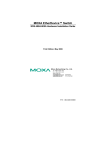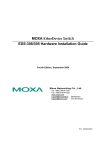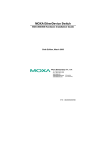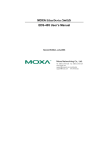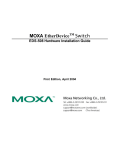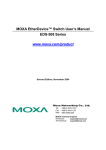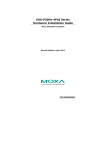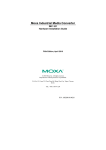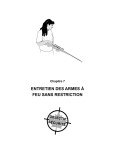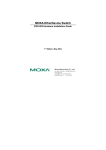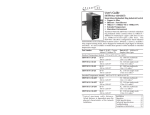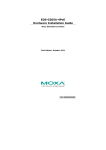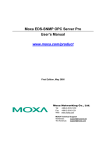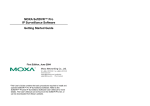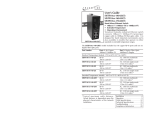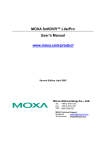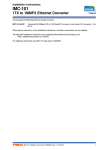Download EDS-508 Hardware Installation Guide
Transcript
MOXA EtherDevice™ Switch EDS-508 Hardware Installation Guide Third Edition, March 2005 Moxa Networking Co., Ltd. Tel: Fax: Web: +886-2-2910-1230 +886-2-2910-1231 www.moxa.com MOXA Technical Support [email protected] Worldwide: The Americas [email protected] TM MOXA EtherDevice Switch EDS-508 Hardware Installation Guide The software described in this manual is furnished under a license agreement and may be used only in accordance with the terms of that agreement. Copyright Notice Copyright © 2005 Moxa Networking Co., Ltd. All rights reserved. Reproduction without permission is prohibited. Trademarks MOXA is a registered trademark of the Moxa Group. All other trademarks or registered marks in this manual belong to their respective manufacturers. Disclaimer Information in this document is subject to change without notice and does not represent a commitment on the part of Moxa. Moxa provides this document “as is,” without warranty of any kind, either expressed or implied, including, but not limited to, its particular purpose. Moxa reserves the right to make improvements and/or changes to this manual, or to the products and/or the programs described in this manual, at any time. Information provided in this manual is intended to be accurate and reliable. However, Moxa assumes no responsibility for its use, or for any infringements on the rights of third parties that may result from its use. This product might include unintentional technical or typographical errors. Changes are periodically made to the information herein to correct such errors, and these changes are incorporated into new editions of the publication. Table of Contents Chapter 1 Introduction .................................................................... 1-1 Why EDS-508 is ideal for Industrial Control and Automation . 1-2 Advanced Network Control Function............................ 1-2 Redundant Ethernet Ring Capability ............................. 1-2 Intelligent Network Management .................................. 1-2 Industrial Grade Reliability ........................................... 1-2 Package Checklist ..................................................................... 1-3 Optional Accessories................................................................. 1-3 Features..................................................................................... 1-4 Panel Views of EDS-508........................................................... 1-5 Panel Views of EDS-508-MM/SS-SC....................................... 1-6 Panel Views of EDS-508-MM-ST ............................................ 1-7 Chapter 2 Installing MOXA EtherDevice™ Switch ....................... 2-1 Mounting Dimensions............................................................... 2-2 DIN-Rail Mounting................................................................... 2-3 Wall Mounting (Optional)......................................................... 2-3 Chapter 3 Wiring MOXA EtherDevice™ Switch ............................ 3-1 Wiring Requirements ................................................................ 3-2 Grounding MOXA EDS-508 .................................................... 3-4 Wiring the Relay Contact.......................................................... 3-4 Wiring the Redundant Power Inputs ......................................... 3-5 Wiring the Digital Inputs........................................................... 3-5 Communication Connections .................................................... 3-6 RS-232 Connection........................................................ 3-7 10/100BaseTx Ethernet Port Connection....................... 3-8 100BaseFx Ethernet Port Connection.......................... 3-10 Chapter 4 Hardware Overview ....................................................... 4-1 Redundant Power Inputs ........................................................... 4-2 Relay Contacts .......................................................................... 4-2 LED Indicators.......................................................................... 4-2 Auto MDI/MDI-X Connection ................................................. 4-4 Fiber Ports................................................................................. 4-4 Dual Speed Functionality and Switching .................................. 4-5 Switching, Filtering, and Forwarding ....................................... 4-6 Switching and Address Learning .............................................. 4-6 Auto-Negotiation and Speed Sensing ....................................... 4-6 Specifications............................................................................ 4-7 Appendix A Service Information .......................................................A-1 MOXA Internet Services.......................................................... A-2 Problem Report Form............................................................... A-3 Return Procedure ..................................................................... A-4 1 Chapter 1 Introduction Welcome to MOXA EtherDevice™ Switch EDS-508 series of industrial 8-Port Managed Redundant Ethernet Switches. The following topics are covered in this chapter: Why EDS-508 is ideal for Industrial Control and Automation ¾ Advanced Network Control Function ¾ Redundant Ethernet Ring Capability ¾ Intelligent Network Management ¾ Industrial Grade Reliability Package Checklist Optional Accessories Features Panel Views of EDS-508 Panel Views of EDS-508-MM/SS-SC Panel Views of EDS-508-MM-ST EDS-508 Hardware Installation Guide Why EDS-508 is ideal for Industrial Control and Automation Advanced Network Control Function ¾ Multicast traffic management—IGMP Snooping function provides the ability to manage multicast traffic. ¾ Network segment planning—The VLAN function not only helps to segment your network without being restricted by physical connections, but is also more secure, and protects against unwanted data transmission. ¾ Traffic prioritization capability—Quality of Service (QoS) provides a traffic prioritization capability to ensure that important data gets delivered consistently and predictably. Redundant Ethernet Ring Capability ¾ Fast recovery time (< 300 ms)—Ensures that your automation system will be back to normal in under 300 ms when the network gets disconnected. ¾ Ring Coupling for Distributed Applications—To give you more flexibility to separate one redundant Ethernet ring into several individual rings for distributed applications. Intelligent Network Management ¾ Automatic relay warning and E-mail warning by user-configured event—To provide the system manager with real-time and designated alarm messages. ¾ SNMP OPC Server with HMI/SCADA software—To let control engineers monitor the network from a central location with existing and familiar visualization and control applications. ¾ Prevent unpredictable network traffic—To give you the capability to restrict unpredictable broadcast and multicast network traffic. ¾ Web-based management—To monitor the real-time status of your network, and better plan your industrial communications system. Industrial Grade Reliability ¾ Extended operating temperature capability—To ensure that your Ethernet equipment can withstand harsh environmental conditions (-40 to 75°C). 1-2 Introduction ¾ Industrial strength safety regulations—To ensure that your Ethernet equipment can withstand critical industrial applications, such as in hazardous locations (UL/cUL Class 1 division 2 and ATEX Class1 Zone 2) and comply with FCC, TÜV, UL, and CE Standards. ¾ Long-haul transmit distance of 40 km or 80 km—To extend your transmission distance to meet fully the application criteria of Transportation Automation, Power distribution, and Utility Automation. Package Checklist MOXA EtherDevice™ Switch is shipped with the following items. If any of these items is missing or damaged, please contact your customer service representative for assistance. y y y y y y y 1 MOXA EtherDevice Switch EDS-508 Hardware Installation Guide CD-ROM with User’s Manual and Windows Utility Moxa Product Warranty RJ45 to DB9 Console port cable Protective caps for unused ports Panel mounting kit (optional—must order separately) Optional Accessories y DR-4524—45W/2A DIN-Rail 24 VDC Power Supply with 85 to 264 VAC input y DR-75-24—75W/3.2A DIN-Rail 24 VDC Power Supply with 85 to 264 VAC input y DR-120-24—120W/5A DIN-Rail 24 VDC Power Supply with 88 to 132 VAC/176 to 264 VAC input by switch y EDS-SNMP OPC Server Pro—CD with EDS-SNMP OPC Server Software and manual y ADP-SCm-STf-M—Multi-mode SC male to ST female duplex adapter, gray color y ADP-SCm-STf-S—Single-mode SC male to ST female duplex adapter, blue color y WK-46—Wall Mounting Kit 1-3 EDS-508 Hardware Installation Guide Features ¾ Advanced Industrial Networking Capability y Redundant Self-Healing Ethernet Ring Capability (recovery time < 300 ms at full load) y IGMP Snooping for filtering multicast traffic from industrial Ethernet Protocols y Supports IEEE 802.1Q VLAN and GVRP protocol to ease network planning y Supports QoS—IEEE 802.1p/1Q and TOS/DiffServ to increase determinism y Port Trunking for flexible network bandwidth utilization. y SNMP V1/V2c/V3 for high security network management. ¾ Designed for Industrial Applications y Bandwidth management to prevent unpredictable network status y Lock port for authorized MAC address access only y Port mirroring for online debugging y Automatic warning by exception through email, relay output y Digital inputs to integrate sensors and alarms with IP networks y Automatic recovery of connected device’s IP addresses y Line-swap fast recovery (patent pending) y Redundant, dual DC power inputs y -40 to 75°C operating temperature range y IP 30, rugged high-strength case y DIN-Rail or panel mounting ability y For hazardous location (UL/cUL Class 1 Div. 2 and ATEX Class 1 Zone 2) y Long-haul transmission distance of 40 km or 80 km. ¾ Useful Utilities and Remote Configuration y Configurable by Web browser, Telnet/Serial console, Windows utility, and SNMP y Send ping commands to identify network segment integrity 1-4 Introduction Panel Views of EDS-508 P.G. 1 RS-232 CONSOLE I2 DI2 I1 2 DI1 V2+ 4 PWR1 V2V1 V2 INPUTS: 24 VDC 3 V1+ PWR1 V2- RELAY2 5 RELAY1 1. 2. 3. 4. 5. PWR1 6 7 14 PWR2 8 FAULT MASTER COUPLER 7 5 3 6 17 10 12 13 4 100M 1 8 9 10 15 2 10M EDS-508 16 18 19 6. 7. 8. 9. 10. 11. 12. 13. 14. 15. 16. 17. 18. 19. Grounding screw Console port Heat dissipation orifices 6-pin terminal block for DI 1, DI 2, and PWR 2 6-pin terminal block for PWR1, Relay 1, and Relay 2 10/100BaseT(X) Port 8 10/100BaseT(X) Port 7 PWR 1, power input 1 LED PWR 2, power input 2 LED Fault LED MASTER LED COUPLER LED Turbo Ring inside Mark 10/100BaseT(X) Port TP port’s 100 Mbps LED TP port’s 10 Mbps LED Model Name Screw hole for Wall Mounting Kit DIN-Rail Kit 18 1-5 EDS-508 Hardware Installation Guide Panel Views of EDS-508-MM/SS-SC P.G. 1 RS-232 CONSOLE I2 DI2 I1 2 DI1 V2+ 4 PWR1 V2V1 V2 INPUTS: 24 VDC 3 V1+ PWR1 V2- RELAY2 5 RELAY1 PWR1 6 PWR2 8 FAULT MASTER 7 COUPLER 7 14 5 3 6 17 5. 11 12 6. 7. 8. 9. 10. 11. 12. 13. 14. 15. 16. 17. 18. 19. 13 15 2 10M EDS-508-MM-SC 16 18 19 18 1-6 1. 2. 3. 4. 8 9 10 4 100M 1 NOTE: The appearance of EDS-508-SS-SC is identical to EDS-508-MM-SC. Grounding screw Console port Heat dissipation orifices 6-pin terminal block for DI 1, DI 2, and PWR 2 6-pin terminal block for PWR1, Relay 1, and Relay 2 100BaseFX Port 8 100BaseFX Port 7 PWR 1, power input 1 LED PWR 2, power input 2 LED Fault LED MASTER LED COUPLER LED Turbo Ring inside Mark 10/100BaseT(X) Port TP port’s 100 Mbps LED TP port’s 10 Mbps LED Model Name Screw hole for Wall Mounting Kit DIN-Rail Kit Introduction Panel Views of EDS-508-MM-ST P.G. 1 RS-232 CONSOLE I2 DI2 I1 2 DI1 V2+ 4 PWR1 V2V1 V2 INPUTS: 24 VDC 3 V1+ PWR1 V2- RELAY2 5 RELAY1 1. 2. 3. 4. 5. PWR1 6 PWR2 8 FAULT MASTER 7 COUPLER 7 14 5 3 6 17 11 12 13 4 100M 1 8 9 10 15 2 10M EDS-508-MM-ST 16 18 19 6. 7. 8. 9. 10. 11. 12. 13. 14. 15. 16. 17. 18. 19. Grounding screw Console port Heat dissipation orifices 6-pin terminal block for DI 1, DI 2, and PWR 2 6-pin terminal block for PWR1, Relay 1, and Relay 2 100BaseFX Port 8 100BaseFX Port 7 PWR 1, power input 1 LED PWR 2, power input 2 LED Fault LED MASTER LED COUPLER LED Turbo Ring inside Mark 10/100BaseT(X) Port TP port’s 100 Mbps LED TP port’s 10 Mbps LED Model Name Screw hole for Wall Mounting Kit DIN-Rail Kit 18 1-7 2 Chapter 2 Installing MOXA EtherDevice™ Switch This chapter includes information about installing MOXA EtherDevice™ Switch. The following topics are covered in this chapter: Mounting Dimensions DIN-Rail Mounting Wall Mounting (Optional) EDS-508 Hardware Installation Guide Mounting Dimensions Side View 30.00 105.00 30.00 9.00 20.00 35.00 135.00 (Unit = mm) 15.0 9.0 49.0 30 PWR1 PWR2 8 + FAULT MASTER + 7 + + + 7.75 9.0 39.37 COUPLER 3.50 6.00 ++ 3.50 + 6.00 + + + + 30.50 55.0 6 66.80 10 57.05 10 5 7.75 9.0 135.00 5 6 3 4 46.77 100M 1 2 10M + 24.56 2-2 Back View + + + + + + + + EDS-508 Front View + 30.00 80.50 + + Panel Mount Kit Installing MOXA EtherDevice™ Switch DIN-Rail Mounting The aluminum DIN-Rail attachment plate should already be fixed to the back panel of EDS-508 when you take it out of the box. If you need to reattach the DIN-Rail attachment plate to EDS-508, make sure the stiff metal spring is situated towards the top, as shown in the figures below. STEP 1—Insert the top of the DIN-Rail into the slot just below the stiff metal spring. STEP 2—The DIN-Rail attachment unit will snap into place as shown below. metal spring DIN-Rail metal spring DIN-Rail To remove EDS-508 from the DIN-Rail, simply reverse Steps 1 and 2 above. Wall Mounting (Optional) For some applications, you will find it convenient to mount MOXA EDS-508 on the wall, as illustrated below. 2-3 EDS-508 Hardware Installation Guide STEP 1—Remove the aluminum DIN-Rail attachment plate from the MOXA EDS-508 rear panel, and then attach the wall mount plates, as shown in the following diagram. Top plate Bottom plate STEP 2—Mounting MOXA EDS-508 on the wall requires 4 screws. Use the EDS-508, with wall mount plates attached, as a guide to mark the correct locations of the 4 screws. The heads of the screws should be less than 6.0 mm in diameter, and the shafts should be less than 3.5 mm in diameter, as shown in the figure at the right. NOTE 3.5 mm Before tightening the screws into the wall, make sure the screw head and shank size are suitable by inserting the screw into one of the keyhole-shaped apertures of the Wall Mounting Plates. Do not screw the screws in all the way—leave about 2 mm to allow room for sliding the wall mount panel between the wall and the screws. STEP 3—Once the screws are fixed in the wall, insert the four screw heads through the large parts of the keyhole-shaped apertures, and then slide EDS-508 downwards, as indicated below. Tighten the four screws for more stability. 2-4 6.0 mm PWR1 PWR2 8 FAULT PWR1 PWR2 8 FAULT MASTER COUPLER 7 5 3 MASTER 6 5 4 3 100M 1 2 10M EDS-508-MM-SC COUPLER 7 6 4 100M 1 2 10M EDS-508-MM-SC 3 Chapter 3 Wiring MOXA EtherDevice™ Switch This chapter includes technical information about connecting MOXA EDS-508 to an external power source and to an external alarm system, and shows you what types of cables you should use for the Console port, Ethernet ports, and optical fiber ports. The following topics are covered in this chapter: Wiring Requirements Grounding MOXA EDS-508 Wiring the Relay Contact Wiring the Redundant Power Inputs Wiring the Digital Inputs Communication Connections ¾ RS-232 Connection ¾ 10/100BaseTx Ethernet Port Connection ¾ 100BaseFx Ethernet Port Connection EDS-508 Hardware Installation Guide Wiring Requirements WARNING Do not disconnect modules or wires unless power has been switched off or the area is known to be non-hazardous. The devices may only be connected to the supply voltage shown on the type plate. The devices are designed for operation with a Safety Extra-Low Voltage. Thus, they may only be connected to the supply voltage connections and to the signal contact with the Safety Extra-Low Voltages (SELV) in compliance with IEC950/ EN60950/ VDE0805. WARNING Substitution of components may impair suitability for Class I, Division 2 and Zone 2. These devices must be supplied by a SELV source as defined in Low Voltage Directive 73/23/EEC and 93/68/EEC. WARNING This equipment has been evaluated as EEx nC IIC T4 equipment under DEMKO Certificate No. 03 ATEX 0324537U. Each module is II 3G and is suitable for use in Zone 2 Explosive marked Atmospheres. The device must be installed in a minimum IP 54 enclosure as defined in IEC 60529 and EN 60529. 3-2 Wiring MOXA EtherDevice™ Switch ATTENTION This unit is a built-in type. When the unit is installed in another piece of equipment, the equipment enclosing the unit must comply with fire enclosure regulation IEC 60950/EN60950 (or similar regulation). ATTENTION Safety First! Be sure to disconnect the power cord before installing and/or wiring your MOXA EtherDevice Switch. Calculate the maximum possible current in each power wire and common wire. Observe all electrical codes dictating the maximum current allowable for each wire size. If the current goes above the maximum ratings, the wiring could overheat, causing serious damage to your equipment. You should also pay attention to the following points: y Use separate paths to route wiring for power and devices. If power wiring and device wiring paths must cross, make sure the wires are perpendicular at the intersection point. y NOTE: Do not run signal or communications wiring and power wiring in the same wire conduit. To avoid interference, wires with different signal characteristics should be routed separately. y You can use the type of signal transmitted through a wire to determine which wires should be kept separate. The rule of thumb is that wiring that shares similar electrical characteristics can be bundled together. y Keep input wiring and output wiring separated. y It is strongly advised that you label wiring to all devices in the system when necessary. 3-3 EDS-508 Hardware Installation Guide Grounding MOXA EDS-508 Grounding and wire routing help limit the effects of noise due to electromagnetic interference (EMI). Run the ground connection from the ground screw to the grounding surface prior to connecting devices. ATTENTION This product is intended to be mounted to a well-grounded mounting surface such as a metal panel. Wiring the Relay Contact EDS-508 has two sets of relay output—relay 1 and relay 2. Each Relay Contact consists of the two contacts of the terminal block on EDS-508’s top panel. You may refer to the next section for detailed instructions on how to connect the wires to the terminal block connector, and how to attach the terminal block connector to the terminal block receptor. In this section, we will explain the meaning of the two contacts used to connect the Relay Contact. Relay1 Relay1 3-4 Relay2 Relay2 FAULT: The two sets of relay contacts of the 6-pin terminal block connector are used to detect user-configured events. The two wires attached to the Fault contacts form an open circuit when a user-configured event is triggered. If a user-configured event does not occur, the Fault circuit will be closed. Wiring MOXA EtherDevice™ Switch Wiring the Redundant Power Inputs EDS-508 has two sets of power input—power input 1 and power input 2.The top two contacts and the bottom two contacts of the 6-pin terminal block connector on EDS’s top panel are used for EDS’s two digital inputs. Top and front views of one of the terminal block connectors are shown here. V1- V1+ STEP 1: Insert the negative/positive DC wires into the V-/V+ terminals. STEP 2: To keep the DC wires from pulling loose, use a small flat-blade screwdriver to tighten the wire-clamp screws on the front of the terminal block connector. STEP 3: Insert the plastic terminal block connector prongs into the terminal block receptor, which is located on EDS-508’s top panel. V2- V2+ PWR1 PWR2 V1- V1+ V2- V2+ PWR1 PWR2 Wiring the Digital Inputs EDS-508 has two sets of digital input, DI 1 and DI 2. Each DI consists of two contacts of the 6-pin terminal block connector on EDS’s top panel, which are used for EDS’s two DC inputs. Top and front views of one of the terminal block connectors are shown here. I1 DI1 I1 DI1 I2 DI2 I2 D I2 STEP 1: Insert the negative (ground)/positive DI wires into the ┴/I1 terminals. STEP 2: To keep the DI wires from pulling loose, use a small flat-blade screwdriver to tighten the wire-clamp screws on the front of the terminal block connector. STEP 3: Insert the plastic terminal block connector prongs into the terminal block receptor, which is located on EDS-508’s top panel. 3-5 EDS-508 Hardware Installation Guide Communication Connections All models of EDS-508 have one RJ45 console port (RS-232 interface), and between six and eight 10/100BaseTX Ethernet ports. Some models also have one or two 100BaseFX (SC/ST-type connector) fiber ports. In this section, we present two types of diagrams—Pinout Diagrams and Cable Wiring Diagrams—to convey information about the ports and the cables used to connect MOXA EDS-508 to other devices: Pinouts—The meaning of the “Pinouts” diagrams is straightforward. The diagrams simply display the type of signal passing through each of the port’s pins. Cable Wiring—Diagrams labeled “Cable Wiring” present standard cable wiring schemes for cables used to connect MOXA EtherDevice Switch’s ports to other devices. These diagrams display three pieces of information: 1. When building your own cable, refer to the “pin-to-pin” Cable Wiring information displayed between the two vertical dashed lines to see which pin of the connector on the left should be connected to which pin of the connector on the right. 2. The information to the left of the left vertical dashed lines gives the pinouts of the relevant MOXA EtherDevice Switch port. 3. The information to the right of the right vertical dashed line gives the pinouts of the opposing device’s port. NOTE 3-6 1. The pin numbers for male DB9 and DB25 connectors, and hole numbers for female DB9 and DB25 connectors are labeled on the connector. However, the numbers are typically quite small, so you may need to use a magnifying glass to see the numbers clearly. 2. The pin numbers for both 8-pin and 10-pin RJ45 connectors (and ports) are typically not labeled on the connector (or port). Refer to the Pinout and Cable Wiring diagrams below to see how RJ45 pins are numbered Wiring MOXA EtherDevice™ Switch RS-232 Connection MOXA EDS-508 has one RS-232 (10-pin RJ45) console port, located on the top panel. Use either an RJ45-to-DB9 or RJ45-to-DB25 cable (see the cable wiring diagrams below) to connect MOXA EDS-508’s console port to your PC’s COM port. You may then use a console terminal program, such as MOXA PComm Terminal Emulator, to access MOXA EDS-508’s console configuration utility. RJ45 (10-pin) Console Port Pinouts 10-Pin Signal 1 2 3 4 5 6 7 8 9 10 DCD DSR RTS GND TxD RxD GND CTS DTR ----- 1 10 RJ45 (10-pin) to DB9 (F) Cable Wiring Moxa EtherDevice Server COM Port RJ45 Plug Pin 1 RJ45 Connector DCD 1 DSR 2 RTS 3 GND 4/7 TxD 5 RxD 6 CTS 8 DTR 9 Female DB9 Connector Cable Wiring 1 6 7 5 3 2 8 4 DCD DTR CTS GND RxD TxD RTS DSR 3-7 EDS-508 Hardware Installation Guide RJ45 (10-pin) to DB25 (F) Cable Wiring Moxa EtherDevice Server COM Port RJ45 Plug Pin 1 RJ45 Connector DCD 1 DSR 2 RTS 3 GND 4/7 TxD 5 RxD 6 CTS 8 DTR 9 Female DB25 Connector Cable Wiring 8 6 4 7 2 3 5 20 DCD DTR CTS GND RxD TxD RTS DSR 10/100BaseTx Ethernet Port Connection The 10/100BaseTX ports located on MOXA EtherDevice Switch’s front panel are used to connect to Ethernet-enabled devices. Most users will choose to configure these ports for Auto MDI/MDI-X mode, in which case the port’s pinouts are adjusted automatically depending on the type of Ethernet cable used (straight-through or cross-over), and the type of device (NIC-type or HUB/Switch-type) connected to the port. In what follows, we give pinouts for both MDI (NIC-type) ports and MDI-X (HUB/Switch-type) ports. We also give cable wiring diagrams for straight-through and cross-over Ethernet cables. 3-8 Wiring MOXA EtherDevice™ Switch RJ45 (8-pin, MDI) Port Pinouts 8-Pin Description 1 2 3 6 Tx+ TxRx+ Rx- 1 8 RJ45 (8-pin, MDI-X) Port Pinouts 8-Pin Description 1 2 3 6 Rx+ RxTx+ Tx- 1 8 RJ45 (8-pin) to RJ45 (8-pin) Straight-Through Cable Wiring Straight-Through Cable Switch Port RJ45 Plug Pin 1 RJ45 Connector Tx+ TxRx+ Rx- NIC Port RJ45 Connector Cable Wiring 3 6 1 2 3 6 1 2 Rx+ RxTx+ Tx- 3-9 EDS-508 Hardware Installation Guide RJ45 (8-pin) to RJ45 (8-pin) Cross-Over Cable Wiring Cross-Over Cable Switch Port (NIC Port) RJ45 Plug Pin 1 RJ45 Connector (Rx+) (Rx-) (Tx+) (Tx-) Tx+ TxRx+ Rx- Switch Port (NIC Port) RJ45 Connector Cable Wiring 3 6 1 2 1 2 3 6 Rx+ RxTx+ Tx- (Tx+) (Tx-) (Rx+) (Rx-) 100BaseFx Ethernet Port Connection The concept behind the SC/ST port and cable is quite straightforward. Suppose you are connecting devices I and II. Contrary to electrical signals, optical signals do not require a circuit in order to transmit data. Consequently, one of the optical lines is used to transmit data from device I to device II, and the other optical line is used transmit data from device II to device I, for full-duplex transmission. All you need to remember is to connect the Tx (transmit) port of device I to the Rx (receive) port of device II, and the Rx (receive) port of device I to the Tx (transmit) port of device II. If you are making your own cable, we suggest labeling the two sides of the same line with the same letter (A-to-A and B-to-B, as shown below, or A1-to-A2 and B1-to-B2). SC Port Pinouts SC-Port to SC-Port Cable Wiring A A B B Tx Cable Wiring Rx 3-10 A B A B Wiring MOXA EtherDevice™ Switch ST Port Pinouts ST-Port to ST-Port Cable Wiring A A B B Tx Cable Wiring Rx A B A B ATTENTION This is a Class 1 Laser/LED product. To prevent damage to your eyes, do not stare directly into the laser beam. 3-11 4 Chapter 4 Hardware Overview This chapter is an overview of MOXA EDS-508’s various hardware features. The following topics are covered in this chapter: Redundant Power Inputs Relay Contacts LED Indicators Auto MDI/MDI-X Connection Fiber Ports Dual Speed Functionality and Switching Switching, Filtering, and Forwarding Switching and Address Learning Auto-Negotiation and Speed Sensing Specifications EDS-508 Hardware Installation Guide Redundant Power Inputs MOXA EDS-508 has two DC power inputs located on its top panel. For detailed instructions on how to connect the power wires to the terminal block connector, see the Wiring the Redundant Power Inputs section from Chapter 3. From the user’s point of view, the function of the redundant power inputs is quite straightforward. Both inputs can be connected simultaneously to live DC power sources. If one power source fails, the other live source acts as a backup, and automatically supplies all of MOXA EDS-508’s power needs. Relay Contacts MOXA EDS-508 has two Relay Contacts located on the top panel. For detailed instructions on how to connect the Relay Contact power wires to the 6-pin terminal block connector, see the Wiring the Relay Contact section from Chapter 3. The Alarm Contact has two terminals that form a Fault circuit for connecting to an alarm system. These two contacts form a closed circuit when MOXA EDS-508 is receiving power from both DC power inputs. The circuit opens if power to one of the power inputs is cut off, or if the MOXA EDS-508 self-test fails, alerting the user to check either the power supply or function of the Server. The Alarm Contact has two terminals that form a Fault circuit for connecting to an alarm system. Two wires attached to the Fault contacts form an open circuit when a user-configured event is triggered. If a user-configured event does not occur, the Fault circuit will be closed. A typical scenario would be to connect the Fault circuit to a warning light located in the control room. The light can be set up to switch on when a fault is detected. LED Indicators The front panel of MOXA EDS-508 contains several LED indicators. The function of each LED is described in the table below. 4-2 Hardware Overview LED Color PWR1 AMBER PWR2 FAULT MASTER AMBER State On Power is being supplied to power input P1. Off Power is not being supplied to power input P1. On Power is being supplied to power input P2. Off Power is not being supplied to power input P2. On When the corresponding PORT alarm is enabled, and a user-configured event is triggered. Off When the corresponding PORT alarm is enabled and a user-configured event is not triggered, or when the corresponding PORT alarm is disabled. On When the EDS-508 is the Master of this Turbo Ring RED Green Blinking COUPLER 10M 100M (TP) 100M (FX) GREEN GREEN When the EDS-508 is Ring Master of this Turbo Ring and the Turbo Ring is broken. On When the EDS-508 enables the coupling function to form a back-up path. Off When the EDS-508 disables the coupling function. On TP port’s 10 Mbps link is active. Green GREEN Description Blinking Data is being transmitted at 10 Mbps. Off TP Port’s 10 Mbps link is inactive. On TP port’s 100 Mbps link is active. Blinking Data is being transmitted at 100 Mbps. Off 100BaseTX Port’s link is inactive. On FX port’s 100 Mbps is active. Blinking Off Data is being transmitted at 100 Mbps. 100BaseFX port is inactive. 4-3 EDS-508 Hardware Installation Guide Auto MDI/MDI-X Connection The Auto MDI/MDI-X function allows users to connect MOXA EtherDevice Switch’s 10/100BaseTX ports to any kind of Ethernet device, without paying attention to the type of Ethernet cable being used for the connection. To understand the meaning of this statement, you simply need to remember that there are two types of Ethernet ports, and two types of Ethernet cables. See the 10/100BaseTX Ethernet Port Connection section from Chapter 3 for detailed Pinout and Cable Wiring diagrams. In this section, we give a short primer of the terminology, and indicate which cable should be used to connect which types of ports. There are two types of Ethernet port. The first type is called an MDI (Medium Dependant Interface) port, and is what you find on your PC’s NIC (Network Interface Card). The second type is called an MDI-X (Medium Dependant Interface, Crossover) port, and is the type of port found on a standard HUB or switch. For this reason, we often refer to an MDI port as being NIC-type, and an MDI-X port as being HUB/Switch-type. There are also two types of Ethernet cable. The first type is a straight-through cable, and the second type is a cross-over cable. The general connection rules are: y A straight-through cable is used to connect unlike ports: MDI Q MDI-X. y A cross-over cable is used to connect like ports: MDI Q MDI or MDI-X Q MDI-X. For example, you should use a straight-through cable to connect your computer’s Ethernet NIC to a HUB or switch, but use a cross-over cable to connect your computer’s Ethernet NIC to another computer’s Ethernet NIC. Fiber Ports MOXA EtherDevice Switch’s fiber switched ports operate at a fixed 100 Mbps speed and full-duplex mode to provide the best performance. The fiber ports are factory-built as either a multi-mode or single-mode SC/ST connector. Consequently, you should use fiber cables that have SC/ST connectors at both ends. When plugging the connector into the port, make sure the slider guide is positioned to the right side so that it fits snuggly into the port. 4-4 Hardware Overview SC Connector slider guide slider ridges slider ST Connector slider guide slider ridges slider The 100 Mbps fiber ports are switched ports, and perform as a domain, providing a high bandwidth backbone connection that supports long fiber cable distances (up to 5 km for multi-mode, and 15, 40, or 80 km for single-mode) for installation versatility. Dual Speed Functionality and Switching MOXA EDS-508’s 10/100 Mbps RJ45 switched ports can be configured for 10 Mbps operation, 100 Mbps operation, or to auto-negotiate with the connected device for the fastest data transmission rate supported by both devices. All models of MOXA EDS-508 are plug-and-play devices, so that software configuration is not required at installation, or during maintenance. The half/full duplex mode for the switched RJ45 ports is user dependent and changes (by auto-negotiation) to full or half duplex, depending on which transmission speed is supported by the attached device. 4-5 EDS-508 Hardware Installation Guide Switching, Filtering, and Forwarding Each time a packet arrives at one of the switched ports, a decision is made to either filter or forward the packet. Packets with source and destination addresses belonging to the same port segment will be filtered, constraining those packets to one port, and relieving the rest of the network from the need to process them. A packet with destination address on another port segment will be forwarded to the appropriate port, and will not be sent to the other ports where it is not needed. Packets that are used in maintaining the operation of the network (such as the occasional multi-cast packet) are forwarded to all ports. MOXA EDS-508 operates in the store-and-forward switching mode, which eliminates bad packets and enables peak performance to be achieved when there is heavy traffic on the network. Switching and Address Learning MOXA EDS-508 has an address table that can hold up to 2000 node addresses, which makes it suitable for use with large networks. The address tables are self-learning, so that as nodes are added or removed, or moved from one segment to another, MOXA EDS-508 automatically keeps up with new node locations. An address-aging algorithm causes the least-used addresses to be deleted in favor of newer, more frequently used addresses. To reset the address buffer, power down the unit and then power it back up. Auto-Negotiation and Speed Sensing All of MOXA EDS-508’s RJ45 Ethernet ports independently support auto-negotiation for speeds in the 10BaseT and 100BaseTX modes, with operation according to the IEEE 802.3u standard. This means that some nodes could be operating at 10 Mbps, while at the same time, other nodes are operating at 100 Mbps. Auto-negotiation takes place when an RJ45 cable connection is made, and then each time a LINK is enabled. MOXA EtherDevice Switch advertises its capability for using either 10 Mbps or 100 Mbps transmission speeds, with the device at the other end of the cable expected to similarly advertise. Depending on what type of device is connected, this will result in agreement to operate at a speed of either 10 Mbps or 100 Mbps. 4-6 Hardware Overview If a MOXA EDS-508 RJ45 Ethernet port is connected to a non-negotiating device, it will default to 10 Mbps speed and half-duplex mode, as required by the IEEE 802.3u standard. Specifications Technology Standards Protocols MIB Forwarding and Filtering Rate Processing Type Flow Control Address Table Size Interface RJ45 Ports Fiber Ports Console LED Indicators Alarm Contact Digital Input IEEE802.3, 802.3u, 802.3x, 802.1D, 802.1W, 802.1Q, 802.1p IGMP V1/V2/V3 device, GVRP, SNMP V1/V2C/V3, DHCP Server/Client, BootP, TFTP, SNTP, SMTP, RARP and EDS-SNMP OPC server (Optional) MIB-II, Ethernet-Like MIB, P-BRIDGE MIB, Q-BRIDGE MIB, Bridge MIB, RSTP MIB 148800 pps Store and Forward IEEE802.3x flow control, back pressure flow control 2K uni-cast addresses 10/100BaseT(X) auto negotiation speed, F/H duplex mode, and auto MDI/MDI-X connection 100BaseFX ports (SC/ST connector) RS-232 (RJ45) Power, Fault, 10/100M, Ring Master and Ring Coupler Two relay outputs with current carrying capacity of 1A @ 24 VDC Two inputs with the same ground, but electrically isolated from the electronics • For state “1”: +13 to +30V • For state “0”: -30 to +3V • Max. input current: 8 mA 4-7 EDS-508 Hardware Installation Guide Optical Fiber Multi Single Single Single mode mode, 15 mode, 40 mode, 80 Distance, km 5 15 40 80 Wavelength, nm 1300 1310 1310 1550 Min. TX Output, dBm -20 -15 -5 -5 Max. TX Output, dBm -14 -6 0 0 Sensitivity, dBm -34 to -30 -36 to -32 -36 to -32 -36 to -32 Recommended Diam. (Core/Cladding) μm 50/125 9/125 9/125 9/125 (1 dB/km, 800 MHz × km) Power Input Voltage 12 to 48 VDC, redundant inputs Input Current (@24V) 0.29A: (EDS-508) 0.43A: (EDS-508-MM-SC, EDS-508-SS-SC, EDS-508-MM-ST) Connection Two removable 6-pin terminal blocks Overload Current Protection Present, can withstand 1.6A Reverse Polarity Protection Present Mechanical Casing Dimensions Weight Installation Casing 4-8 IP30 protection, metal case 80.5 x 135 x 105 mm (W x H x D) 1.04 kg DIN-Rail, Wall Mounting (optional kit) IP30 protection, aluminum case Hardware Overview Environmental Operating Temperature 0 to 60°C (32 to 140°F) -40 to 75°C (-40 to 167°F ) for -T models Storage Temperature -40 to 85°C (-40 to 185°F) Ambient Relative Humidity 5% to 95% (non-condensing) Regulatory Approvals Safety UL60950 (E212360), UL 508, CSA C22.2 No. 60950, EN60950 (E212360) Hazardous Location UL/cUL Class I, Division 2, Groups A, B, C, and D (E238559). ATEX Class I, Zone 2, EEx nC IIC (03CA24537) EMI FCC Part 15, CISPR (EN55022) class A EMS EN61000-4-2 (ESD), Level 3 EN61000-4-3 (RS), Level 3 EN61000-4-4 (EFT), Level 3 EN61000-4-5 (Surge), Level 3 EN61000-4-6 (CS), Level 3 EN61000-4-8 EN61000-4-11 EN61000-4-12 Shock IEC60068-2-27 Freefall IEC60068-2-32 Vibration IEC60068-2-6 WARRANTY 5 years 4-9 A Appendix A Service Information This appendix shows you how to contact Moxa about this and other products, and how to report problems. The following topics are covered in this chapter: Moxa Internet Services Problem Report Form Return Procedure EDS-508 Hardware Installation Guide MOXA Internet Services Customer satisfaction is our number one concern, and to ensure that customers receive the full benefit of our products, Moxa Internet Services has been set up to provide technical support, driver updates, product information, and user’s manual updates. The following services are provided: E-mail for technical support [email protected] World Wide Web (WWW) Site for product information: http://www.moxa.com A-2 Service Information Problem Report Form MOXA EDS-508 Series Customer name: Company: Tel: Fax: Email: Date: 1. Moxa Product: EDS-508 EDS-508-MM-SC EDS-508-SS-SC EDS-508-SS-SC-80 EDS-508-T EDS-508-MM-SC-T EDS-508-SS-SC-T EDS-508-SS-SC-80-T EDS-508-MM-ST EDS-508-MM-ST-T 2. Serial Number: _________________ Problem Description: Please describe the symptoms of the problem as clearly as possible, including any error messages you see. We may need to follow your description to reproduce the symptoms, so please give a complete description of the problem. A-3 EDS-508 Hardware Installation Guide Return Procedure For product repair, exchange, or refund, the customer must: ¾ Provide evidence of original purchase. ¾ Obtain a Product Return Agreement (PRA) from the sales representative or dealer. ¾ Fill out the Problem Report Form (PRF). Include as much detail as possible for a shorter product repair time. ¾ Carefully pack the product in an anti-static package, and send it, pre-paid, to the dealer. The PRA should be visible on the outside of the package, and include a description of the problem, along with the return address and telephone number of a technical contact. A-4











































